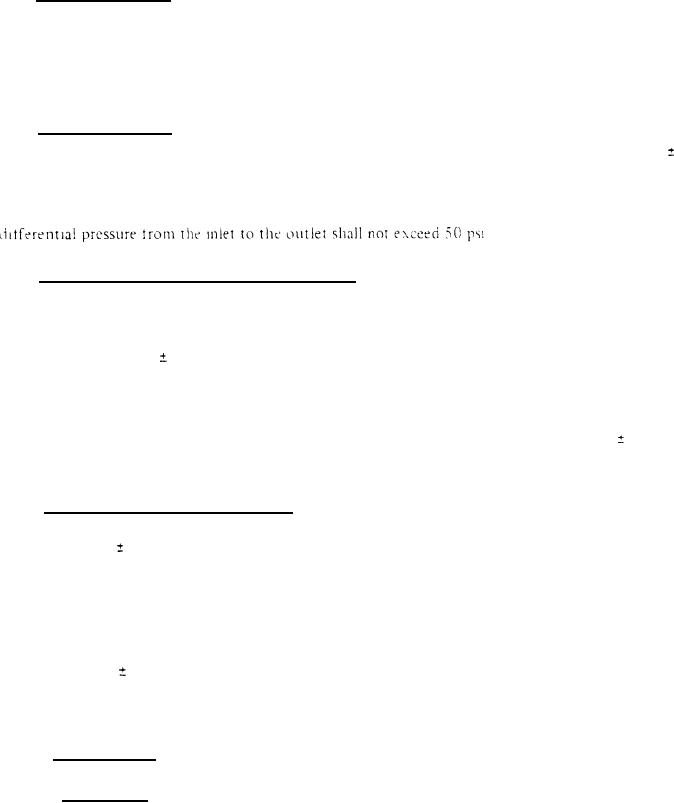 |
|||
|
|
|||
| ||||||||||
|
|  MIL-F-27656C(USAF)
4.6.2 Proof pressure test. The filter unit shall be assembled with the outlet port plugged. The filter
unit shall then be filled with clean test fluid and a pressure of 7,500 psig shall be applied for the
Type I assembly and 10,000 psig for the Type II assemblies, at least twice and held for 2 minutes
at each application. The pressure shall be reduced to zero between applications. Any evidence of
permanent deformation malfunction, or leakage shall be cause for rejection.
4.6.3 Pressure drop test. The plug in the outlet end of the filter unit shall be removed and a pressure
indicator installed at the outlet and inlet of the housing. The indicator shall be accurate to within 1/2
percent of full scale-reading. Elements which have successfully withstood the tests specified in para-
graphs 4.6.1 and 4.6.2.1 shall be installed and a flow of 30 gpm for the Type I assemblies and 35 gpm for
the Type II assemblies with an oil temperature stabilized at 100 F shall be directed through the unit The
4.6.4 Differential pressure indicator operation test. With the outlet of the filter unit partially blocked.
the pressure at the relet to the filter unit shall be slowly increased until the differential pressure indicator
is fully actuated. For this test, a 24-V or 110-V power supply and test light shall be wired through the
pressure indicator device. The test light shall illuminate when the differential pressure between the inlet
and outlet reaches 100 15 psi. The pressure shall be raised to 5,000 psi (the outlet may be totally
blocked for this portion of the test). The pressure shall be returned to zero, and the test light shall remain
illuminated. The indicator shall be manually reset. The above shall be considered one complete cycle
and shall be conducted 24 tunes. Twelve cycles shall be accomplished using 24-V input, and twelve
cycles shall be accomplished using 110-V input. Failure of the indicator to actuate at 100 15 psi on
any one of the above 24 cycles shall be cause for rejection.
4.6.5 Extreme temperature operation test The filter unit shall be subjected to -65 F for 24 hours.
During this period, pressure applied shall not exceed 10 psi. At the end of this period, a differential
pressure of 100 15 psi shall be created by applying flow through the unit and continuing this flow
for 10 minutes. The differential pressure indicator shall actuate within its specified range. The flow
during this test shall be recorded. Proof pressure shall then be applied to the relet port for 2 minutes
with the outlet blocked. The fluid used for these tests shall be not warmer than -65 F. This test shall
then be repeated at -40 and +20 F. The unit shall then be removed from the cold chamber and placed
in a temperature environment of + 160 F within 20 minutes. Flow shall be resumed until a differential
pressure of 100 15 psi has been obtained The differential pressure indicator shall actuate within
its specified range. The element shall be removed and shall successfully withstand the test specified in
paragraph 4.6.6.1.
4.6.6 Element tests
4.6.6.1 Bubble test. The test element shall be installed in a setup similar to that shown on figure 5
Should the design of the filter unit make it impractical to conduct the bubble test with airflow from
inside-out, the test may be conducted with airflow from outside-in provided the test setup is approved
by the procuring activity. The fluid level shall be maintained 1/2 inch above the test element. The
element shall be slowly rotated whale the air pressure is gradually increased by means of the needle
valve. The area of greatest porosity shall be determined by observing the first bubble on the surface
of the element and the manometer reading in inches of water at which this bubble emerges from the
element. This shall be recorded as the initial bubble point. The initial bubble point pressure for each
element shall be not less than 0.90 times the minimum qualification bubble point.
16
|
|
Privacy Statement - Press Release - Copyright Information. - Contact Us |